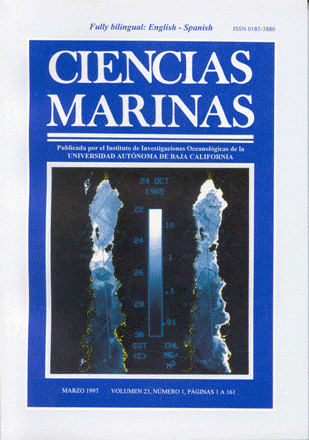The use of bacterial counts in two mexican shrimp hatcheries
Main Article Content
Abstract
En dos laboratorios situados en la República Mexicana. Se realizaron conteos de bacterias heterótrofas viables, bacterias tipo Vibrio y coliformes totales en muestras de agua del sistema de aprovicionamiento. en alimentos marinos y en estanques de reproductores. Las altas concentraciones de estos grupos bacterianos indican la existencia de puntos de riesgo, los cuales deben ser vigilados sistemáticamente para poder controlar patógenos potenciales, tales como Vibrio spp. En este trabajo, se encontró que los sistemas de filtración y el alimento utilizado, tal como Artemia spp. y organismos marinos Frescos o congelados, son las principales fuentes de patógenos potenciales en los laboratorios de acuicultura estudiados.
Counts of viable heterotrophic bacteria, Vibrio-like bacteria and total coliforms were performed in seawater supply, food stocks and broodstock pools at two aquacultural facilities located in Mexico. |00E2|??The high abundance of these bacterial groups indicates risk areas that must be monitored to control potential pathogens, such as Vibrio spp. Filtering systems and food supplies, such as Artemia spp. and fresh or frozen sea food. were found to be the most important sources of potential pathogens.
Counts of viable heterotrophic bacteria, Vibrio-like bacteria and total coliforms were performed in seawater supply, food stocks and broodstock pools at two aquacultural facilities located in Mexico. |00E2|??The high abundance of these bacterial groups indicates risk areas that must be monitored to control potential pathogens, such as Vibrio spp. Filtering systems and food supplies, such as Artemia spp. and fresh or frozen sea food. were found to be the most important sources of potential pathogens.
Downloads
Download data is not yet available.
Article Details
How to Cite
M.L. Lizarraga-Partida, Montoya-Rodríguez, L., & Gendrop-Funes, V. (1997). The use of bacterial counts in two mexican shrimp hatcheries. Ciencias Marinas, 23(1), 129–140. https://doi.org/10.7773/cm.v23i1.770
Issue
Section
Research Article
This is an open access article distributed under a Creative Commons Attribution 4.0 License, which allows you to share and adapt the work, as long as you give appropriate credit to the original author(s) and the source, provide a link to the Creative Commons license, and indicate if changes were made. Figures, tables and other elements in the article are included in the article’s CC BY 4.0 license, unless otherwise indicated. The journal title is protected by copyrights and not subject to this license. Full license deed can be viewed here.

